Aztecs: Facts And History About The Ancient And Powerful Mesoamerican Civilization From Aztlán
A. Sutherland - AncientPages.com - The Aztecs said they came from a mythical place called Aztlán. The Aztecs were one of the world’s greatest civilizations and they created an empire that stretched over vast territories.
Aztec warriors were fearsome and cruel and warfare was the driving force of the Aztecs’ economy and religion. The Aztec empire is long gone, but the legacy of these interesting ancient people is still alive and we can admire the remarkable buildings and ruins they left behind.
In this article, we examine facts and history about the Aztecs, one of the greatest ancient civilizations of Mesoamerica.
Aztlán – The Mythical Homeland Of The Aztecs
The Aztecs also called Mexicas believe they came from a place called Aztlán, (also spelled Aztlan or sometimes Aztalan). In the Nahua language, Aztlan means “the Place of Whiteness” or “the Place of the Heron”. Researchers have long debated whether Aztlán was a real place or simply a myth.
Nahuatl myths tell that seven tribes lived in Chicomoztoc, or "the place of the seven caves". Each cave represented a different Nahua group: the Xochimilca, Tlahuica, Acolhua, Tlaxcalteca, Tepaneca, Chalca, and Mexica. When the tribes left the caves, they created a settlement "near" Aztlán.
According to the myth, the Aztecs left Aztlan guided by one of their gods until they arrived in the Texcoco Lake, in what’s now Mexico City, where they founded Tenochtitlan, the capital of the Aztec empire, in the year 1325. The Aztec migration and their original homeland Aztlán are mentioned in several codexes left by the Aztecs such as the codex Boturini o Tira de la Peregrinacion as well as Spanish chroniclers including Bernal Diaz del Castillo, Bernardino de Sahagun, and Diego Duran.
The Aztecs were by no means the first civilization to create cities in Mexico, a country with an ancient history that goes back 20,000 years. Before the Aztecs, there were the cultures of Teotihuacan, Monte Alban, Palenque, and Tajin.
In the 14th century, this civilization began a large expansion and they conquered lands in Mexico and Mesoamerica through wars.
Fearsome Aztec Eagle Warriors And Jaguar Warriors Of Mesoamerica
The Aztecs were not peaceful people. Warfare played a central role in their society and was the driving force of their economy and religion. The Aztec army’s secret to success was a good organization and well-trained and determined warriors who had a large variety of offensive and defensive weapons.
Some of the most skilled and feared fighting forces of the ancient world were the Aztec Eagle Warriors and Jaguar Warriors. For 200 years, they were the most dominant and terrifying warrior force in Mesoamerica. They created a huge and ruthless empire. All went well until they came face to face with an enemy even stronger than themselves, an enemy they could never conquer. This devastating encounter was the beginning of the end. When the Spaniards arrived in the early 16th century, the Aztecs ruled over 370 small city-states that paid tribute in goods to Tenochtitlan, the capital of the Aztec empire.
Aztec Society
Aztec society was very complex. It was socially divided between the nobility and the populace. The nobles included the ruler, the priests, and the military, all of whom had privileges and did not pay taxes. The poorer people had to work as painters, poets, sculptors, peasants, doctors, or architects. They attended schools to learn their trades and received military training to be prepared for wars. They also attended schools to learn about religion, music, and their language, the Nahuatl.
Much of the Aztec society was based on agriculture. To improve their agriculture, the Aztecs built so-called chinampas - small, artificial islands created on a freshwater lake. The chinampas resembled floating gardens.
Chinampas were used throughout the Valley of Mexico around the lake bed and were, without doubt, one of the reasons why Aztec farming became famous.
Like most ancient civilizations, they used slaves for a variety of tasks, but these people had much broader rights than slaves in almost any other society in human history. Slavery in the Aztec Empire was very different from what Europeans of the same period established in their colonies.
Aztec Religion And Body Modification
Aztecs worshipped a number of gods. Their two most important deities were Huitzilopochtli, the god of war, and Tlaloc, the god of rain. Religion was very important to the Aztecs and it had elements of human sacrifice in connection with a large number of religious festivals that were held according to patterns of the Aztec calendar. The Sun Stone (Stone of the Five Eras), or sometimes (erroneously) called Aztec calendar stone was rediscovered during repairs in Mexico City.
The sculpted motifs that cover the surface of the stone refer to the main elements of the Mexica cosmogony.
In the center of the monolith, there is a depiction of the solar deity, Tonatiuh, holding a human heart in each of his clawed hands, and his tongue is represented by a stone sacrificial knife (Tecpatl). The four squares surrounding the central deity represent the four previous suns (or eras), 4 Movement (Nahuatl: Nahui Ollin). Each era ended with the destruction of the world and humanity, which were then recreated in the next era.
The Aztecs believed that when the solar and sacred cycles fell on the same day, the universe was in great danger. So every 52 years, they performed an elaborate ceremony of human sacrifice.
Many Mesoamerican civilizations practiced body modification, often for ritual or ceremonial purposes. Body modification was a symbol of power among the Aztec rulers.
Aztecs believed that blood was very important because the spiritual essence of man existed in his blood, which also explains all the blood sacrifices they performed. To the Aztecs, body alteration was also considered an important part of the movement between major life stages.
The Fall Of The Great Aztec Empire
During their time, the Aztecs were one of the world’s greatest civilizations. With a population of about 200,000 people, their capital Tenochtitlan was one of the world’s largest cities in the 16th century.
The Aztecs called their ruler the Huey Tlatoani, the highest political, military, and religious leader. This person spoke in both the divine and human realms. The city-states of the Aztec Empire each had their own Huey Tlatoani with the ultimate power.
The Aztecs were defeated by the Spaniards. Moctezuma II was the emperor who first confronted — and succumbed to — Hernan Cortes. When the Spaniards landed in 1519 in what is today Veracruz, the local people there, the Totonacas, complained to conquistador Hernan Cortes that they were subjugated by Moctezuma, the señor of Tenochtitlan. When Cortes heard this, he promised that they would be freed from paying tribute if they become their allies to overthrow Moctezuma.
An independent republic called Tlaxcallan in what is now central Mexico was founded in the mid-13th century and, by 1500 was effectively surrounded by the Aztec Empire, but never lost its independence. Researchers who studied the history of Tlaxcallan discovered that there were many international relations in the region. In fact, Tlaxcallan supported Cortés and played a critical role in the Spanish Conquest of Mexico in the 16th century.
There is a myth that 800 Spaniards managed to defeat the whole Aztec empire but it’s not entirely true. The Spaniards defeated the whole Aztec empire but with the help of thousands of indigenous people who wanted to get rid of Aztec rule.
Written by – A. Sutherland - AncientPages.com Senior Staff Writer
Copyright © AncientPages.com All rights reserved. This material may not be published, broadcast, rewritten or redistributed in whole or part without the express written permission of AncientPages.com
Expand for referencesMore From Ancient Pages
-
 Ancient Romans Used The Poisonous Black Henbane Plant As Hallucinogenic Medicine
Archaeology | Feb 9, 2024
Ancient Romans Used The Poisonous Black Henbane Plant As Hallucinogenic Medicine
Archaeology | Feb 9, 2024 -
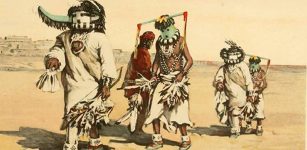 Zuni Indians Bravely Fought For Their Ancient Culture, Traditions And Respect For Their Ancestors
Featured Stories | Mar 14, 2018
Zuni Indians Bravely Fought For Their Ancient Culture, Traditions And Respect For Their Ancestors
Featured Stories | Mar 14, 2018 -
 Fragment Of Unique Ancient Greek Terracotta Statue Uncovered In Underwater Diggings
Archaeology | Mar 26, 2017
Fragment Of Unique Ancient Greek Terracotta Statue Uncovered In Underwater Diggings
Archaeology | Mar 26, 2017 -
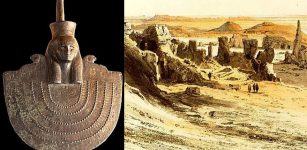 City Of Sais: Prehistoric Prestigious Cult Center Of Northern Egypt
Featured Stories | Oct 31, 2016
City Of Sais: Prehistoric Prestigious Cult Center Of Northern Egypt
Featured Stories | Oct 31, 2016 -
 Jiangshi – Terrifying Vicious Ancient Chinese Vampire In Disguise
Chinese Mythology | Jun 11, 2020
Jiangshi – Terrifying Vicious Ancient Chinese Vampire In Disguise
Chinese Mythology | Jun 11, 2020 -
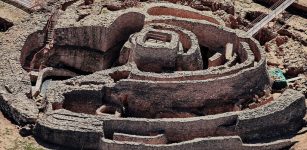 Motilla del Azuer: Impressive And Unusual 3,200-Year-Old Fortress
Featured Stories | Nov 13, 2018
Motilla del Azuer: Impressive And Unusual 3,200-Year-Old Fortress
Featured Stories | Nov 13, 2018 -
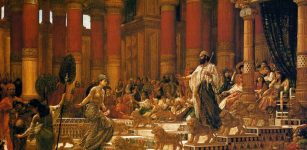 The Magnificent Ancient ‘Flying Airship’ Of King Solomon
Featured Stories | Aug 27, 2018
The Magnificent Ancient ‘Flying Airship’ Of King Solomon
Featured Stories | Aug 27, 2018 -
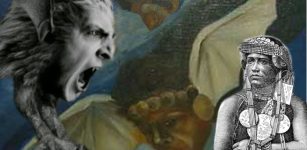 Chonchon ‘Tue Tue’ Bird With Human Head Brought Bad Omens To Places It Haunted In Beliefs Of Mapuche Indians
Featured Stories | Mar 12, 2024
Chonchon ‘Tue Tue’ Bird With Human Head Brought Bad Omens To Places It Haunted In Beliefs Of Mapuche Indians
Featured Stories | Mar 12, 2024 -
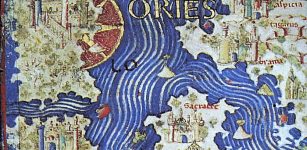 Fra Mauro Medieval Map: Accurate And Detailed Work Attesting To Advanced Geographic Knowledge Of Contemporary Cartographers
Artifacts | Feb 8, 2019
Fra Mauro Medieval Map: Accurate And Detailed Work Attesting To Advanced Geographic Knowledge Of Contemporary Cartographers
Artifacts | Feb 8, 2019 -
 Polycarp Of Smyrna: Burned At The Stake And Pierced With A Dagger
Featured Stories | Jun 25, 2020
Polycarp Of Smyrna: Burned At The Stake And Pierced With A Dagger
Featured Stories | Jun 25, 2020 -
 World’s Oldest Marine Navigation Tool Was A Sophisticated Astrolabe
Archaeology | Oct 25, 2017
World’s Oldest Marine Navigation Tool Was A Sophisticated Astrolabe
Archaeology | Oct 25, 2017 -
 Major Underwater Archaeological Find On The Western Coast Of Sicily – Artifacts From The Battle Of The Egadi Islands?
Archaeology | Sep 11, 2023
Major Underwater Archaeological Find On The Western Coast Of Sicily – Artifacts From The Battle Of The Egadi Islands?
Archaeology | Sep 11, 2023 -
 London’s Underground Rivers Were Deliberately Hidden
Featured Stories | Oct 8, 2018
London’s Underground Rivers Were Deliberately Hidden
Featured Stories | Oct 8, 2018 -
 Ominous Black Layer – A Geological Anomaly Or Scientific Evidence Of A Great Ancient Cosmic Catastrophe?
Featured Stories | Jan 29, 2019
Ominous Black Layer – A Geological Anomaly Or Scientific Evidence Of A Great Ancient Cosmic Catastrophe?
Featured Stories | Jan 29, 2019 -
 Scientists Question Whether Meat Eating Really Changed Human Evolution
Archaeology | Jan 25, 2022
Scientists Question Whether Meat Eating Really Changed Human Evolution
Archaeology | Jan 25, 2022 -
 Unique 2,000-Year-Old Decorated Roman Sandal Lost By Well-Cleaner Found In Spain
Archaeology | Oct 19, 2023
Unique 2,000-Year-Old Decorated Roman Sandal Lost By Well-Cleaner Found In Spain
Archaeology | Oct 19, 2023 -
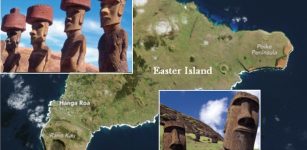 Easter Island Secrets: Giant ‘Pukao’ Stone Hats Reveal That Rapa Nui People Were Not Warriors
Archaeology | Dec 22, 2017
Easter Island Secrets: Giant ‘Pukao’ Stone Hats Reveal That Rapa Nui People Were Not Warriors
Archaeology | Dec 22, 2017 -
 Ancient DNA Yields Surprising Findings On World’s Earliest Seafarers
Archaeology | Jun 30, 2022
Ancient DNA Yields Surprising Findings On World’s Earliest Seafarers
Archaeology | Jun 30, 2022 -
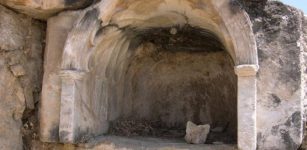 Plutonium: Dangerous Pluto’s Gate Was An Ancient Gateway To Hell At Hierapolis That Was Real
Featured Stories | Feb 18, 2017
Plutonium: Dangerous Pluto’s Gate Was An Ancient Gateway To Hell At Hierapolis That Was Real
Featured Stories | Feb 18, 2017 -
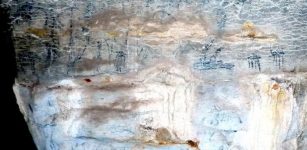 Madagascar Cave Art Hints At Ancient Connections Between Africa And Asia
Featured Stories | Dec 18, 2023
Madagascar Cave Art Hints At Ancient Connections Between Africa And Asia
Featured Stories | Dec 18, 2023





